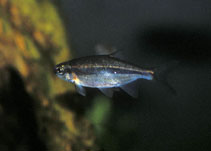http://www.fishbase.org/Summary/speciesSummary.php?genusname=Richardsonius&speciesname=balteatus ---> http://192.134.151.83/Summary/speciesSummary.php?genusname=Richardsonius&speciesname=balteatus
http://192.134.151.83/Summary/speciesSummary.php?genusname=Richardsonius&speciesname=balteatus ---> https://fishbase.mnhn.fr/Summary/speciesSummary.php?genusname=Richardsonius&speciesname=balteatus
https://fishbase.mnhn.fr/Summary/speciesSummary.php?genusname=Richardsonius&speciesname=balteatus ---> https://fishbase.mnhn.fr/summary/Richardsonius-balteatus.html
Richardsonius balteatus, Redside shiner

You can
sponsor
this page
Common name (e.g. trout)
Genus + Species (e.g. Gadus morhua)
-

-
About this page
-
Languages
-
User feedbacks
-
Citation
-
Uploads
-
Related species
-


 Redside shiner
Upload your
photos
and
videos
Redside shiner
Upload your
photos
and
videos
Pictures
|
Videos |
Google image
 Richardsonius balteatus
Richardsonius balteatus
Picture by
JJPhoto
Teleostei (teleosts) >
Cypriniformes
(Carps) >
Leuciscidae
(Minnows) > Pogonichthyinae
Etymology:
balteatus:
balteatus
meaning girdled (Ref.
1998
)
.
More on author:
Richardson
.
Environment: milieu / climate zone / depth range / distribution range
Ecology
Freshwater; demersal; depth range 0 - ? m. Temperate; 59°N - 34°N
North America: Pacific Slope drainages from Nass River in British Columbia, Canada to Rogue, Klamath and Columbia River drainages in Oregon, Idaho, Nevada and Wyoming, USA; Bonneville basin in south Idaho, west Wyoming and Utah, USA; Peace River system (Arctic basin) in British Columbia and Alberta, Canada. Introduced into upper Missouri River basin ni Montana and Colorado River drainage in Wyoming, Utah, Colarado and Arizona, USA.
Size / Weight / Age
Maturity: L
m
?
range ? - ? cm
Max length : 18.0 cm TL male/unsexed; (Ref.
5723
); common length : 6.8 cm TL male/unsexed; (Ref.
12193
)
Dorsal
soft rays
(total): 8-12;
Anal
soft rays
: 10 - 24. Body deep and compressed; dorsal fin origin far behind pelvic fin origin; caudal peduncle narrow; caudal fin deeply forked; snout short and point; mouth terminal; eye large; axillary process at pelvic fin base; lateral line decurved, complete wit 52-67 scales; dorsal fin with 8-12 rays (usually 10); anal fin with 10-24 rays (usually 15); intestine long; peritoneum silver; pharyngeal teeth 2,4-4,2 to 2,5-5,2. Olive-gray to brown above, clear to yellow streak above dark stripe along side; red above pectoral fin base on large individuals; clear to yellow-brown fins. Breeding males are brassy yellow, bright red along lower side (Ref.
86798
).
Inhabits runs and flowing to standing pools of headwaters, creeks, and small to medium rivers as well as lakes and ponds. Usually found over mud or sand, often near vegetation (Ref.
5723
,
86798
). Forms schools (Ref.
1998
). Fry feed on diatoms, copepods, ostracods, and other small planktonic and demersal crustaceans (Ref.
1998
). Diet changes to terrestrial and aquatic insects, algae, mollusks, fish eggs (including their own), and small fishes like other redside shiners, other minnows, and trout (Ref.
1998
). Preyed upon by mergansers, loons, and mink (Ref.
1998
).
Adults move into spawning streams in the afternoon and evening. Spawning occurs as one female and one or two males thrash violently side by side for a few seconds. Fertilized eggs adhere to gravel and vegetation on the bottom.
Page, L.M. and B.M. Burr
, 2011. A field guide to freshwater fishes of North America north of Mexico. Boston : Houghton Mifflin Harcourt, 663p. (Ref.
86798
)
IUCN Red List Status (Ref.
130435
)
Least Concern (LC)
; Date assessed:
01 March 2012
CITES
Not Evaluated
Not Evaluated
Threat to humans
Harmless
Human uses
FAO - Publication:
search
|
FishSource
|
More information
Countries
FAO areas
Ecosystems
Occurrences
Introductions
Stocks
Ecology
Diet
Food items
Food consumption
Ration
Common names
Synonyms
Metabolism
Predators
Ecotoxicology
Reproduction
Maturity
Spawning
Spawning aggregation
Fecundity
Eggs
Egg development
Age/Size
Growth
Length-weight
Length-length
Length-frequencies
Morphometrics
Morphology
Larvae
Larval dynamics
Recruitment
Abundance
BRUVS
References
Aquaculture
Aquaculture profile
Strains
Genetics
Electrophoreses
Heritability
Diseases
Processing
Nutrients
Mass conversion
Collaborators
Pictures
Stamps, Coins Misc.
Sounds
Ciguatera
Speed
Swim. type
Gill area
Otoliths
Brains
Vision
Tools
Bio-Quiz
|
E-book
|
Field guide
|
Identification keys
|
Length-frequency wizard
|
Life-history tool
|
Point map
|
Classification Tree
|
Catch-MSY
|
Special reports
Check for Aquarium maintenance
|
Check for Species Fact Sheets
|
Check for Aquaculture Fact Sheets
Download XML
Summary page
|
Point data
|
Common names
|
Photos
Internet sources
AFORO (otoliths) |
Alien/Invasive Species database
|
Aquatic Commons
|
BHL
|
Cloffa
|
BOLDSystems
|
Websites from users
|
Check FishWatcher
|
CISTI
|
Catalog of Fishes
:
genus
,
species
|
DiscoverLife
|
ECOTOX
| FAO - Publication:
search
|
Faunafri
| Fishipedia |
Fishtrace
| GenBank:
genome
,
nucleotide
|
GloBI
|
Google Books
|
Google Scholar
|
Google
| IGFA World Record |
MitoFish
|
Otolith Atlas of Taiwan Fishes
|
PubMed
| Reef Life Survey | Socotra Atlas |
Tree of Life
| Wikipedia:
Go
,
Search
| World Records Freshwater Fishing |
Zoological Record
Estimates based on models
Phylogenetic diversity index (Ref.
82804
): PD
50
= 0.7500 [Uniqueness, from 0.5 = low to 2.0 = high].
Bayesian length-weight: a=0.00851 (0.00376 - 0.01926), b=3.06 (2.86 - 3.26), in cm total length, based on LWR estimates for this (Sub)family-body shape (Ref.
93245
).
Trophic level (Ref.
69278
): 3.4 ±0.49 se; based on food items.
Resilience (Ref.
120179
): Medium, minimum population doubling time 1.4 - 4.4 years (Preliminary K or Fecundity.).
Fishing Vulnerability (Ref.
59153
): Low vulnerability (10 of 100).
Back to Search
Random Species
Back to Top
Accessed through:
Not available
FishBase mirror site :
localhost
Page last modified by :
mrius-barile
- 20 July 2016
Fatal error
: Uncaught ArgumentCountError: Too few arguments to function checkEcotox(), 1 passed in /var/www/html/summary/speciessummary.php on line 2304 and exactly 3 expected in /var/www/html/includes/speciessummary.lib.php:2579 Stack trace: #0 /var/www/html/summary/speciessummary.php(2304): checkEcotox() #1 {main} thrown in
/var/www/html/includes/speciessummary.lib.php
on line
2579
|